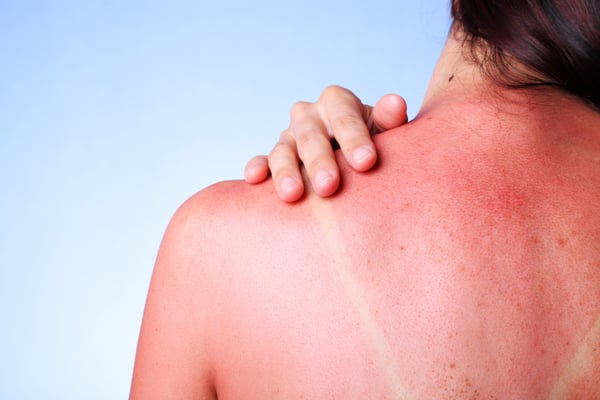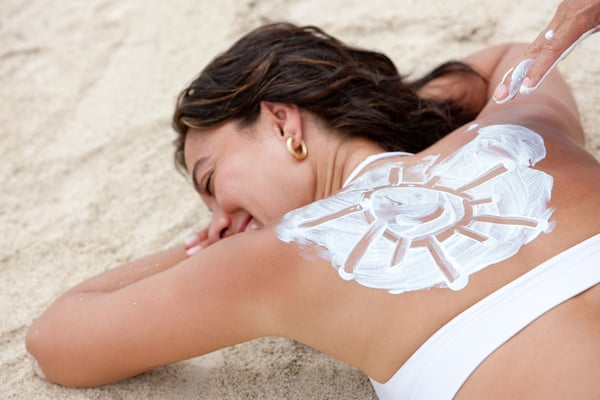Update yourself on the latest knowledge about sun, skin and staying safe!

Skin- & malignant melanoma cancer tripled in 30 years. Learn more about sun rays and wichs SPF to use!
The sun is linked in so many ways to healthy mental health. When the sun is shining, we are in a better mood and would like to go out and enjoy it. But as with so much else, it must be with the way that sun directly on the skin can have major consequences.
These are the facts:
- Sunburn increases the risk of skin cancer
- Sunburn does not only happen during the bathing holiday
- You can get sunburned when it is cloudy
- Being brown does not protect your skin from the sun's harmful rays

Here is more knowledge about rays from the sun, SPF and good advice on how to enjoy the sun.
Sun rays
The sun emits several different rays divided into visible light, UV and Infrared. They each have positive and unfortunately several negative effects on the skin cells.
- Infrared radiation (IR) amounts to approx. 54% of the sun's radiation and cannot be seen with the naked eye. Infrared radiation emits heat, and this is where the primary heat of the sun comes from. IR heat is known by many as beneficial for muscle tension and heat gives a nice well-being when summer comes. However, new studies show that IR can have a negative degrading effect on the skin's collagen, in line with UVA, which ages the skin prematurely.
- Visible light is approx. 39% of the sun's radiation. Visible light gives us the daylight that allows us to discern colors and perceive the world as we know it. At the cold end of the light field, they are purple and blue. The blue light (HEV) must be limited as it consumes on the skin's antioxidant reserves - also applies to LED light sources, smartphones, tablets, and PC monitors. At the warm end of the light field where the energy is lower (LEV) we find yellow, orange, and red light and here there is less risk of skin damage.
- UV radiation amounts to approx. 7% of the sun's radiation and is divided into UVA and UVB (UVC is not mentioned here):
UVA has the longest wavelengths and reaches us everywhere on earth. They penetrate deep into the skin's middle layer (dermis) and are the primary cause of collagen breakdown in the skin throughout life = they cause wrinkles and leathery skin. The UVA rays can penetrate thin clothing, bright umbrellas and can go unobstructed through plain unstained window glass. Remember that UVA = Aging.
UVB cannot penetrate thick cloud cover, ordinary window glass or plain thickness clothing. The UVB rays do not reach deeper into the skin than even the epidermis (Epidermis).
UVB triggers skin pigment to protect skin cells from DNA damage and potential mutations like cancer. The skin thus darkens when it is hit by UVB, but so are the rays that blight. Having a tan color links many to health, which is misunderstood as the darker pigmentation of the skin is a natural defense mechanism that is triggered.
UVB activates vitamin D production in the skin, therefore approx. 10-15 min. UVB radiation on unprotected skin daily recommended. Remember that UVB = Brown skin/burning skin
FACT: You can't get brown through a window; it will only give wrinkles 😊.
Sunscreens in sun lotions have historically focused on protection against UVA and UVB, but new technologies will also include IR, HEV filters and filters that protect against environmental pollution!
What is SPF and which one should I choose?
SPF (Sun Protection factor) tells about a product's degree of UVB protection and must not be higher than SPF50 or SPF50+ in the EU.
A good sun lotion should also contain UVA protection, but that is not revealed in the SPF number. In the EU, a UVA symbol with a ring on the front of a product will say that the content of the UVA filter is high and at least corresponds to 30% of the UVB filter content.
There are almost 30 different permissible filters in the EU, of which 2 are physical and the rest are chemical. Each filter has its own coverage within the UV spectrum, some only protect against UVB, some only against UVA others cover wider over both fields.
Physical SPF filters cover the widest. Zinc oxide covers the entire UVA and UVB spectrum, Titanium oxide covers almost, though not 100% for the UVA field. The physical filters act as a mirror to the sun's rays and act from the moment they are applied. Since both types are white and in powder form, they can feel heavy and sticky on the skin and you see a white color. These filters have been micronized for several years to make them easier, but this can cause irritation to the skin.
Chemical filters are not visible on the skin and must be absorbed into the outermost dead layer (Stratum Corneum) before they work optimally, so give them approx. 15 min. before going into the sun. There will always be several different chemical filters in a cream to provide broad-spectrum protection.
A good mixture of chemical and physical filters will most often provide the most comfortable sun lotion.
Did you know that:
Water Resistant effect in suns lotion, indicates if a sun lotion is suitable for bathing. If a sunscreen has:
- "Water Resistant", it is water resistant for up to 40 minutes
- "Very Water Resistant", it is water resistant for up to 80 minutes

Too little or too much?
Too little or too much sun is the difficult balance. You must know your own skin and know what it can withstand from sun, so burning at any cost is avoided.
We all have different amounts of skin pigment so even if your mother or sister can become brown and get a nice tan-line in 20 minutes, it does not automatically mean you can too. You cannot teach a skin to become brown, especially not but burning it. Sun burns especially in childhood and adolescence is probably the cause of skin cancer development in the affected area later in life.
Here are some tips on how to enjoy the sun:
- Look at the UV index: when it is 3 or higher you must wear sun lotion
- Use the highest possible SPF protection, especially if you have light skin and if it is early in the season.
- Use copious amounts of sunscreen (about 35 ml. for an adult body) to achieve the factor on the label. Reapply every 2 hours or after bathing to maintain protection.
- And then remember the “sun rules” from the authorities like Danish Cancer Society - the 3's: Shade between 12 and 15, Sun hat, and Sun lotion
Find a sunscreen with a texture you like and remember to protect lips, ears and feet that are often forgotten. Enjoy the summer and take care of yourself and your skin and take responsibility for protecting children and adolescents under the age of 18 in the sun.
